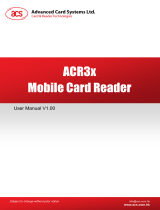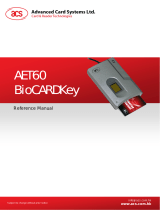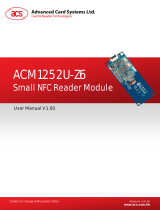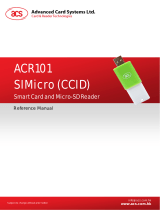Page is loading ...

Subject to change without prior notice info@acs.com.hk
www.acs.com.hk
Reference Manual V1.06
ACR83 PINeasy

ACR83 – Reference Manual info@acs.com.hk
Version 1.06
www.acs.com.hk
Page 2 of 61
Table of Contents
1.0. Introduction ............................................................................................................. 4
1.1. Reference Documents ........................................................................................................... 4
1.2. Symbols and Abbreviations ................................................................................................... 4
2.0. Features ................................................................................................................... 5
3.0. Supported Card Types ............................................................................................ 6
4.0. Smart Card Interface ............................................................................................... 7
4.1. Smart Card Power Supply VCC (C1) .................................................................................... 7
4.2. Programming Voltage VPP C6 .............................................................................................. 7
4.3. Card Type Selection .............................................................................................................. 7
4.4. Interface for Microcontroller-based Cards ............................................................................. 7
4.5. Card Tearing Protection ......................................................................................................... 7
5.0. Power Supply ........................................................................................................... 8
6.0. USB Interface ........................................................................................................... 9
6.1. Communication Parameters .................................................................................................. 9
6.2. Endpoints ............................................................................................................................... 9
7.0. Communication Protocol ...................................................................................... 10
8.0. PC/SC SCardControl Application Programming Interface ................................. 12
8.1. Specific ScardControl .......................................................................................................... 12
8.2. Smart Card Device IOCTLs ................................................................................................. 13
8.2.1. CM_IOCTL_GET_FEATURE_REQUEST .................................................................. 13
8.2.2. FEATURE_VERIFY_PIN_DIRECT ............................................................................. 14
8.2.3. FEATURE_MODIFY_PIN_DIRECT ............................................................................ 16
8.2.4. FEATURE_IFD_PIN_PROP ....................................................................................... 18
8.2.5. IOCTL_SMARTCARD_GET_FIRMWARE_VERSION ............................................... 19
8.2.6. IOCTL_SMARTCARD_DISPLAY_LCD_MESSAGE .................................................. 20
8.2.7. IOCTL_SMARTCARD_READ_KEY ........................................................................... 20
9.0. Operation Flow for PIN Verification and Modification (PC/SC 2.0 Part 10) ........ 22
10.0. CCID SPE Data Structure ...................................................................................... 23
11.0. PIN Verification Data Structure ............................................................................. 24
11.1. Error Checking (Bit) ............................................................................................................. 25
11.2. Error Checking (Byte) .......................................................................................................... 25
11.3. Verification Example 1 ......................................................................................................... 26
11.4. Verification Example 2 ......................................................................................................... 28
11.5. Verification Example 3 ......................................................................................................... 29
12.0. PIN Modification Data Structure ........................................................................... 32
12.1. Modification (Bit) bConfirmPIN Bit1=0 ................................................................................. 33
12.2. Modification (Bit) bConfirmPIN Bit1=0 Data Structure Error Checking ............................... 34
12.3. Modification (Byte) bConfirmPIN Bit1=0 .............................................................................. 34
12.4. Modification (Byte) bConfirmPIN Bit1=0 Data Structure Error Checking ............................ 34
12.5. Modification (Bit) bConfirmPIN Bit1=1 ................................................................................. 34
12.6. Modification (Bit) bConfirmPIN Bit1=1 Data Structure Error Checking ............................... 35
12.7. Modification (Byte) bConfirmPIN Bit1=1 .............................................................................. 35
12.8. Modification (Byte) bConfirmPIN Bit1=1 Data Structure Error Checking ............................ 36
12.9. Modification Example 1 ........................................................................................................ 36
12.10. Modification Example 2 ........................................................................................................ 38
12.11. Modification Example 3 ........................................................................................................ 40
12.12. Modification Example 4 ........................................................................................................ 42
12.13. Modification Example 5 ........................................................................................................ 45

ACR83 – Reference Manual info@acs.com.hk
Version 1.06
www.acs.com.hk
Page 3 of 61
Appendix A. bmFormatString Description .................................................................... 49
Appendix B. bmPINBlockString Description ................................................................ 50
Appendix C. bmPINLengthFormat ................................................................................ 51
Appendix D. Sample Code (PC/SC 2.0 Part 10) ............................................................ 52
Appendix E. Set bKeyReturnCondition ......................................................................... 60
Appendix F. Response Error Codes .............................................................................. 61
List of Figures
Figure 1 : PIN Verification and Modification Operation Flowchart ....................................................... 22

ACR83 – Reference Manual info@acs.com.hk
Version 1.06
www.acs.com.hk
Page 4 of 61
1.0. Introduction
The ACR83, a cost-effective PC-linked PIN-pad reader, serves as an interface for the communication
between a computer (for example, a PC) and a smart card. Different types of smart cards have
different commands and communication protocols, and the ACR83 PINeasy establishes a uniform
interface from the computer to the smart card for a wide variety of cards.
The ACR83 is connected to the computer through a USB interface and uses the CCID interface to
communicate with the USB port. CCID is the Device Class Specification for USB chip/Smart Card
Interface Devices, and defines the communication protocol and commands for the USB chip-card
interface devices.
Furthermore, the ACR83 supports CCID Secure PIN Entry (SPE) functionality which provides a
secure user interface for PIN entry without the danger of the PIN being observed by a third party.
ACR83 is a specific smart card reader which can do the PIN verification and modification in the card
reader.
This Reference Manual will provide the PC/SC APDU commands that are used to control the built-in
peripherals of the ACR83 device, and the data structures for secure PIN verification and modification.
1.1. Reference Documents
The following related documents are available from WWW.USB.ORG
• Universal Serial Bus Specification 2.0 (also referred to as the USB specification), April 27,
2000
• Universal Serial Bus Common Class Specification 1.0, December 16, 1997
• Universal Serial Bus Device Class: Smart Card CCID Specification for Integrated Circuit(s)
Cards Interface Devices, Revision 1.1, April 22, 2005
The following related documents can be ordered through
WWW.ANSI.ORG
• ISO/IEC 7816-1; Identification Cards – Integrated circuit(s) cards with contacts - Part 1:
Physical Characteristics
• ISO/IEC 7816-2; Identification Cards – Integrated circuit(s) cards with contacts - Part 2:
Dimensions and Locations of the contacts
• ISO/IEC 7816-3; Identification Cards – Integrated circuit(s) cards with contacts - Part 3:
Electronic signals and transmission protocols
1.2. Symbols and Abbreviations
Symbol Abbreviation
ATR
Answer-to-Reset
EMV
Europay MasterCard VISA
PPS
Protocol and Parameters Selection
SPE
Secure PIN Entry
USB
Universal Serial Bus

ACR83 – Reference Manual info@acs.com.hk
Version 1.06
www.acs.com.hk
Page 5 of 61
2.0. Features
• 14-key keypad
• 2 rows x 16 characters dot matrix LCD, each character has 5x8 dots
• Supports ISO 7816 Microprocessor Smart Cards with the following features:
o Class A, B, C (5 V, 3 V and 1.8 V respectively)
o T=0 and/or T=1 protocol
• Supports Secure PIN Entry (SPE)
• EMV Level 1 Certified
• Full-speed USB Interface (12 Mbps)
• Compliant to the following standards:
o PC/SC
o Microsoft® WHQL
o CCID
o CE/FCC
o RoHS 2

ACR83 – Reference Manual info@acs.com.hk
Version 1.06
www.acs.com.hk
Page 6 of 61
3.0. Supported Card Types
The ACR83 supports MCU cards with either T=0 or T=1 protocol. The card ATR indicates the specific
operation mode (TA2 present; bit b5 of TA2 must be 0) and when that the particular mode is not
supported by the ACR83 PINeasy, the reader will reset the card to a negotiable mode. If the card
cannot be set to negotiable mode, the reader will then reject the card.
When the card ATR indicates the negotiable mode (TA2 not present) and communication parameters
other than the default parameters, the ACR83 will execute the PPS and try to use the communication
parameters that the card suggested in its ATR. If the card does not accept the PPS, the reader will
use the default parameters (F=372, D=1).
For the meaning of the aforementioned parameters, please refer to ISO 7816 Part 3.

ACR83 – Reference Manual info@acs.com.hk
Version 1.06
www.acs.com.hk
Page 7 of 61
4.0. Smart Card Interface
ACR83 PINeasy Smart Card Reader has a 14-key keypad and LCD display consisting of 2 rows with
16 characters dot matrix.
4.1. Smart Card Power Supply VCC (C1)
The current consumption of the inserted card must not be higher than 100 mA.
4.2. Programming Voltage VPP C6
According to ISO 7816-3, the smart card contact C6 (VPP) supplies the programming voltage to the
smart card. Since all common smart cards in the market are EEPROM-based and do not require the
provision of an external programming voltage, the contact C6 (VPP) has been implemented as a
normal control signal in the ACR83 (CCID). The electrical specifications of this contact are identical to
those of the signal RST (at contact C2).
4.3. Card Type Selection
The controlling PC always has to select the card type through the proper command sent to the ACR83
prior to activation the inserted card.
For MCU-based cards the reader allows to select the preferred protocol, T=0 or T=1. However, this
selection is only accepted and carried out by the reader through the PPS when the card inserted in
the reader supports both protocol types. Whenever an MCU-based card supports only one protocol
type, T=0 or T=1, the reader automatically uses that protocol type, regardless of the protocol type
selected by the application.
4.4. Interface for Microcontroller-based Cards
For microcontroller-based smart cards only the contacts C1 (VCC), C2 (RST), C3 (CLK), C5 (GND)
and C7 (I/O) are used. A frequency of 4 MHz is applied to the CLK signal (C3).
4.5. Card Tearing Protection
The ACR83 (CCID) provides a mechanism to protect the inserted card when it is suddenly withdrawn
while it is powered up. The power supply to the card and the signal lines between the ACR83 (CCID)
and the card are immediately deactivated when the card is being removed. As a general rule,
however, to avoid any electrical damage, a card should only be removed from the reader while it is
powered down.
Note: The ACR83 (CCID) does never, by itself, switch on the power supply to the inserted card. This
must be explicitly done by the controlling computer through the proper command sent to the reader.

ACR83 – Reference Manual info@acs.com.hk
Version 1.06
www.acs.com.hk
Page 8 of 61
5.0. Power Supply
The ACR83 (CCID) requires a voltage of 5 V DC, 100 mA regulated power supply. The ACR83
(CCID) gets the power from PC through the cable supplied along with each type of reader.

ACR83 – Reference Manual info@acs.com.hk
Version 1.06
www.acs.com.hk
Page 9 of 61
6.0. USB Interface
The ACR83 (CCID) is connected to a computer through a USB port following the USB standard.
6.1. Communication Parameters
The ACR83 (CCID) is connected to a computer through USB as specified in the USB Specification
1.1. The ACR83 (CCID) is working in full-speed mode, i.e. 12 Mbps.
Pin Signal Function
1 VBUS
+5 V power supply for the reader
2 D-
Differential signal transmits data between ACR83 and PC
3 D+
Differential signal transmits data between ACR83 and PC
4 GND
Reference voltage level for power supply
Table 1: USB Interface Wiring
Note: ACR83 PINeasy is a PC/SC Device. In order for the ACR83 (CCID) to function properly
through USB interface, an ACS PC/SC driver has to be installed. Please refer to the Device Driver
Installation Guide for more details.
6.2. Endpoints
The ACR83 (CCID) uses the following endpoints to communicate with the host computer:
Control Endpoint For setup and control purpose
Bulk OUT For command to sent from host to ACR83 (CCID) (data packet size is 64
bytes)
Bulk IN For response to sent from ACR83 (CCID) to host (data packet size is 64
bytes)
Interrupt IN For card status message to sent from ACR83 (CCID) to host (data packet
size is 8 bytes)

ACR83 – Reference Manual info@acs.com.hk
Version 1.06
www.acs.com.hk
Page 10 of 61
7.0. Communication Protocol
ACR83 (CCID) shall interface with the host with USB connection. A specification, namely CCID, has
been released within the industry defining such a protocol for the USB chip-card interface devices.
CCID covers all the protocols required for operating smart cards and PIN.
The configurations and usage of USB endpoints on ACR83 (CCID) shall follow CCID Section 3. An
overview is summarized below:
• Control Commands are sent on control pipe (default pipe). These include class-specific
requests and USB standard requests. Commands that are sent on the default pipe report
information back to the host on the default pipe.
• CCID Events are sent on the interrupt pipe.
• CCID Commands are sent on BULK-OUT endpoint. Each command sent to ACR83 (CCID)
has an associated ending response. Some commands can also have intermediate responses.
• CCID Responses are sent on BULK-IN endpoint. All commands sent to ACR83 (CCID) have
to be sent synchronously. (i.e. bMaxCCIDBusySlots is equal to 1 for ACR83 (CCID)).
The supported CCID features by ACR83 (CCID) are indicated in its Class Descriptor:
Offset Field Size Value Description
0
bLength
1 36h Size of this descriptor (in bytes)
1
bDescriptorType
1 21h CCID Functional Descriptor type
2
bcdCCID
2 0100h
CCID Specification Release
Number in Binary-coded decimal
4
bMaxSlotIndex
1 00h
One slot is available on ACR83
(CCID)
5
bVoltageSupport
1 07h
ACR83 (CCID) can supply 1.8 V,
3.0 V and 5.0 V to its slot
6
dwProtocols
4 00000003h
ACR83 (CCID) supports T=0 and
T=1 Protocol
10
dwDefaultClock
4 00000FA0h
Default ICC clock frequency is 4
MHz
14
dwMaximumClock
4 00000FA0h
Maximum supported ICC clock
frequency is 4 MHz
18
bNumClockSupported
1 00h
Does not support manual setting
of clock frequency
19
dwDataRate
4 00002A00h
Default ICC I/O data rate is
10752 bps
23
dwMaxDataRate
4 0001F808h
Maximum supported ICC I/O
data rate is 250000 bps
27
bNumDataRatesSupported
1 00h
Does not support manual setting
of data rates
28
dwMaxIFSD
4 00000Feh
Maximum IFSD supported by
ACR83 (CCID) for protocol T=1
is 254
32
dwSynchProtocols
4 00000000h
ACR83 (CCID) does not support
synchronous card

ACR83 – Reference Manual info@acs.com.hk
Version 1.06
www.acs.com.hk
Page 11 of 61
Offset Field Size Value Description
36
dwMechanical
4 00000000h
ACR83 (CCID) does not support
special mechanical
characteristics
40
dwFeatures
4 00010030h
ACR83 (CCID) supports the
following features:
• Automatic ICC clock
frequency change according
to parameters
• Automatic baud rate change
according to frequency and
FI,DI parameters
• TPDU level exchange with
ACR83 (CCID)
44
dwMaxCCIDMessageLength
4 0000010Fh
Maximum message length
accepted by ACR83 (CCID) is
271 bytes
48
bClassGetResponse
1 00h
Insignificant for TPDU level
exchanges
49
bClassEnvelope
1 00h
Insignificant for TPDU level
exchanges
50
wLCDLayout
2 0000h No LCD
52
bPINSupport
1 00h No PIN Verification
53
bMaxCCIDBusySlots
1 01h
Only one slot can be
simultaneously busy

ACR83 – Reference Manual info@acs.com.hk
Version 1.06
www.acs.com.hk
Page 12 of 61
8.0. PC/SC SCardControl Application Programming
Interface
8.1. Specific ScardControl
LONG SCardControl(
SCARDHANDLE hCard,
DWORD dwControlCode,
LPCVOID lpInBuffer,
DWORD nInBufferSize,
LPVOID lpOutBuffer,
DWORD nOutBufferSize,
LPDWORD lpBytesReturned
);
#define IOCTL_SMARTCARD_GET_FIRMWARE_VERSION SCARD_CTL_CODE(2078)
#define IOCTL_SMARTCARD_DISPLAY_LCD_MESSAGE SCARD_CTL_CODE(2079)
#define IOCTL_SMARTCARD_READ_KEY SCARD_CTL_CODE(2080
// PC/SC 2.0 Part 10
#define CM_IOCTL_GET_FEATURE_REQUEST SCARD_CTL_CODE(3400)
Note: Data is stored in little-endian form in which the LSB (Least Significant Byte) is first.
Furthermore, SCardControl command must be declared in the source code.

ACR83 – Reference Manual info@acs.com.hk
Version 1.06
www.acs.com.hk
Page 13 of 61
8.2. Smart Card Device IOCTLs
The following sections discuss the defined smart card device Input/Output Controls (IOCTL).
8.2.1. CM_IOCTL_GET_FEATURE_REQUEST
The CM_IOCTL_GET_FEATURE_REQUEST returns a list of supported features from the reader.
hCard Reference value returned from SCardConnect
dwControlCode CM_IOCTL_GET_FEATURE_REQUEST
lpInBuffer NULL
nInBufferSize Must be the sizeof(ULONG) of IpInBuffer
lpOutBuffer According to PC/SC 2.0 Specification Part 10, the following features had been
defined:
#define FEATURE_VERIFY_PIN_START 0x01
#define FEATURE_VERIFY_PIN_FINISH 0x02
#define FEATURE_MODIFY_PIN_START 0x03
#define FEATURE_MODIFY_PIN_FINISH 0x04
#define FEATURE_GET_KEY_PRESSED 0x05
#define FEATURE_VERIFY_PIN_DIRECT 0x06
#define FEATURE_MODIFY_PIN_DIRECT 0x07
#define FEATURE_MCT_READERDIRECT 0x08
#define FEATURE_MCT_UNIVERSAL 0x09
#define FEATURE_IFD_PIN_PROP 0x0A
#define FEATURE_ABORT 0x0B
In ACR83, the following features are supported:
#define FEATURE_VERIFY_PIN_DIRECT 0x06
#define FEATURE_MODIFY_PIN_DIRECT 0x07
#define FEATURE_IFD_PIN_PROP 0x0A
If the ACR83 reader used supports PC/SC 2.0 Part 10, you will get the following data:
06 04 XX XX XX XX 07 04 XX XX XX XX 0A 04 XX XX XX XXh
where, XX XX XX XXh is the control code for the feature.
nOutBufferSize sizeof(ULONG) of IpOutBuffer
lpBytesReturned pointer to a DWORD that receives the size, in bytes, of the data stored into the
buffer pointed to by lpOutBuffer

ACR83 – Reference Manual info@acs.com.hk
Version 1.06
www.acs.com.hk
Page 14 of 61
8.2.2. FEATURE_VERIFY_PIN_DIRECT
hCard Reference value returned from SCardConnect
dwControlCode CM_IOCTL_GET_FEATURE_REQUEST
IpInBuffer
Offset Field Size Value Description
0
bTimeOut
1 -
Number of seconds. If the value
is equal to 00h, then default
value is used.
1
bTimeOut2
1 00h
Not supported. Number of
seconds after first key stroke.
2
bmFormatString
1 -
Several parameters for the PIN
format options. For more
information, please refer to
Appendix A.
3
bmPINBlockString
1 -
Defines the length in bytes of the
PIN block to present in the
APDU command. For more
information, please refer to
Appendix B.
4
bmPINLengthFormat
1 -
Allows the insertion of the PIN
length in the APDU command.
For more information, please
refer to Appendix C.
5
wPINMaxExtraDigit
2 XXYYh
XXh: Maximum PIN size in digit
YYh: Minimum PIN size in digit
7
bEntryValidationCondition
1 -
The value is a bit wise OR
operation.
01h = Maximum size reached
02h = Validation key pressed
04h = Timeout occurred
8
bNumberMessage
1 FFh
Number of messages to display
for PIN verification
9
wLangId
2 0409h Language for messages
11
bMsgIndex
1 00h Message index (should be 00h)
12
bTeoPrologue
3 000000h
T=1 I-block prologue field to use
(fill with 00h)
15
ulDataLength
4 -
Length of data to be sent to the
ICC
19
abData
- - Data to send to the ICC
nInBufferSize 19 + uLDataLength
IpOutBuffer

ACR83 – Reference Manual info@acs.com.hk
Version 1.06
www.acs.com.hk
Page 15 of 61
Offset Field Size Value Description
0
abStatus
2 -
6400h: SPE operation timed out
6401h: SPE operation was cancelled by the
“Cancel” button
6402h: Modify PIN operation failed because
two “New PIN” entries do not match
6403h: User entered too short or too long PIN
regarding MIN/MAX PIN Length.
Note: ACR83 will not return this status
because it checks the PIN length during input.
6B80h: Invalid parameter in passed structure
SW1SW2: Result from the card
nOutBufferSize 2
IpBytesReturned Pointer to a DWORD that receives the size, in bytes, of the data stored into the
buffer pointed to by IpOutBuffer.

ACR83 – Reference Manual info@acs.com.hk
Version 1.06
www.acs.com.hk
Page 16 of 61
8.2.3. FEATURE_MODIFY_PIN_DIRECT
hCard Reference value returned from SCardConnect
dwControlCode CM_IOCTL_GET_FEATURE_REQUEST
IpInBuffer
Offset Field Size Value Description
0
bTimeOut
1 -
Number of seconds. If value is
equal to 00h, then default value
is used.
1
bTimeOut2
1 00h
Not supported. Number of
seconds after first key stroke.
2
bmFormatString
1 -
Several parameters for the PIN
format options. For more
information, please refer to
Appendix A.
3
bmPINBlockString
1 -
Defines the length in bytes of the
PIN block to present in the APDU
command. For more information,
please refer to Appendix B.
4
bmPINLengthFormat
1 -
Allows the insertion of the PIN
length in the APDU command.
For more information, please
refer to Appendix C.
5
bInsertionOffsetOld
1 -
Insertion position offset in byte
for the current PIN
6
bInsertionOffsetNew
1 -
Insertion position offset in byte
for the new PIN
7
wPINMaxExtraDigit
2 XXYYh
XXh: Maximum PIN size in digit
YYh: Minimum PIN size in digit
9
bConfirmPIN
1
00h,
01h,
02h,
03h
Indicates if a confirmation is
requested before acceptance of a
new PIN (meaning that the user
has to enter this new PIN twice
before it is accepted)
Indicates if the current PIN must
be entered and set in the same
APDU field of not.
b0: (0/1)
If 0 = No confirmation requested
If 1 = Confirmation requested
b1: (0/1)
If 0 = No current PIN entry
requested. (In this case, the
bInsertinoOffsetOld value must
not be taken into account.)
If 1 = Current PIN entry
requested
b2 – b7: RFU

ACR83 – Reference Manual info@acs.com.hk
Version 1.06
www.acs.com.hk
Page 17 of 61
Offset Field Size Value Description
10
bEntryValidationCondition
1 -
The value is a bit wise OR
operation.
01h = Maximum size reached
02h = Validation key pressed
04h = Timeout occurred
11
bNumberMessage
1 FFh
Number of messages to display
for PIN verification
12
wLangId
2 0409h Language for message
14
bMsgIndex1
1 00h Index of 1st prompting message
15
bMsgIndex2
1 01h Index of 2nd prompting message
16
bMsgIndex3
1 02h Index of 3rd prompting message
17
bTeoPrologue
3 000000h
T=1 I-block prologue field to use
(fill with 00h).
20
ulDataLength
4 -
Length of Data to be sent to the
ICC
24
abData
- Data to send to the ICC
nInBufferSize 24 + ulDataLength
lpOutBuffer
Offset Field Size Value Description
0
abStatus
2 -
6400h: SPE operation timed out
6401h: SPE operation was cancelled using the
“Cancel” button
6402h: Modify PIN operation failed because
two “New PIN” entries do not match
6403h: User entered too short or too long PIN
regarding MIN/MAX PIN Length.
Note: ACR83 will not return this status
because it checks the PIN length during input.
6B80h: Invalid parameter in passed structure
SW1SW2: Result from the card
nOutBufferSize 2
lpBytesReturned Pointer to a DWORD that receives the size, in bytes, of the data stored into
the buffer pointed to by lpOutBuffer.

ACR83 – Reference Manual info@acs.com.hk
Version 1.06
www.acs.com.hk
Page 18 of 61
8.2.4. FEATURE_IFD_PIN_PROP
hCard Reference value returned from SCardConnect.
dwControlCode Return from CM_IOCTL_GET_FEATURE_REQUEST.
lpInBuffer NULL
LpOutBuffer
Offset Field Size Value Description
0
wLcdLayout
2 0210h
Display characteristics: 2 lines,
16 characters per line
2
bEntryValidationCondition
1 07h
Support timeout reached,
maximum PIN size reached,
validation key pressed
3
bTimeOut2
1 00h
0 = IFD does not distinguish
bTimeOut from bTimeOut2
1 = IFD distinguishes
bTimeOut from bTimeOut2
nOutBufferSize 4
lpBytesReturned Pointer to a DWORD that receives the size, in bytes, of the data stored into
the buffer pointed to by lpOutBuffer.

ACR83 – Reference Manual info@acs.com.hk
Version 1.06
www.acs.com.hk
Page 19 of 61
8.2.5. IOCTL_SMARTCARD_GET_FIRMWARE_VERSION
The IOCTL_SMARTCARD_GET_FIRMWARE_VERSION enables Get Firmware Version command.
8.2.5.1. Firmware Version
To acquire device firmware version, take the third element of the received buffer and shift it by 8 bits.
Set the result to an OR operation together with the fourth element of the received buffer.
Example: Firmware_Version = (Common.RecvBuff[2] << 8) | Common.RecvBuff[3]);
8.2.5.2. LCD
To acquire the device’s LCD, take the fifth element of the received buffer and shift it by 8 bits. Set the
result to an OR operation together with the sixth element of the received buffer.
Input:
hCard Reference value returned from SCardConnect
dwControlCode IOCTL_SMARTCARD_GET_FIRMWARE_VERSION
Output:
lpOutBuffer Output value of command
Shift lpOutBuffer[2] by 8 bits
Set OR operation with the shifted
lpOutBuffer[2] and lpOutBuffer[3]
value
Shift lpOutBuffer[4] by 8 bits
Set OR operation with the shifted
lpOutBuffer[4] and lpOutBuffer[5]
value

ACR83 – Reference Manual info@acs.com.hk
Version 1.06
www.acs.com.hk
Page 20 of 61
nOutBufferSize sizeof(ULONG) of lpOutBuffer
lpBytesReturned Pointer to a DWORD that receives the size, in bytes, of the data stored into
the buffer pointed to by lpOutBuffer
Offset Field Size Value Description
0
abStatus
2 0000h SUCCESS
2
wACR83Firmware
2 -
4
LCD
2 -
8.2.6. IOCTL_SMARTCARD_DISPLAY_LCD_MESSAGE
The IOCTL_SMARTCARD_DISPLAY_LCD_MESSAGE enables display LCD message command.
hCard Reference value returned from SCardConnect
dwControlCode IOCTL_SMARTCARD_DISPLAY_LCD_MESSAGE
lpInBuffer Set value for Display LCD message option
nInBufferSize sizeof(ULONG) of lpInBuffer
Offset Field Size Value Description
0
abLCDmessage
0-32 - LCD message (maximum 32 characters)
Output:
lpOutBuffer Output value of command
nOutBufferSize sizeof(ULONG) of lpOutBuffer
lpBytesReturned Pointer to a DWORD that receives the size, in bytes, of the data stored into
the buffer pointed to by lpOutBuffer
Offset Field Size Value Description
0
abStatus
2
0000h
0001h
SUCCESS
BAD_PARAMETER
8.2.7. IOCTL_SMARTCARD_READ_KEY
The IOCTL_SMARTCARD_READ_KEY enables Read Key command.
Input:
hCard Reference value returned from SCardConnect
dwControlCode IOCTL_SMARTCARD_READ_KEY
lpInBuffer Set value for Display LCD message option
nInBufferSize sizeof(ULONG) of lpInBuffer
/










